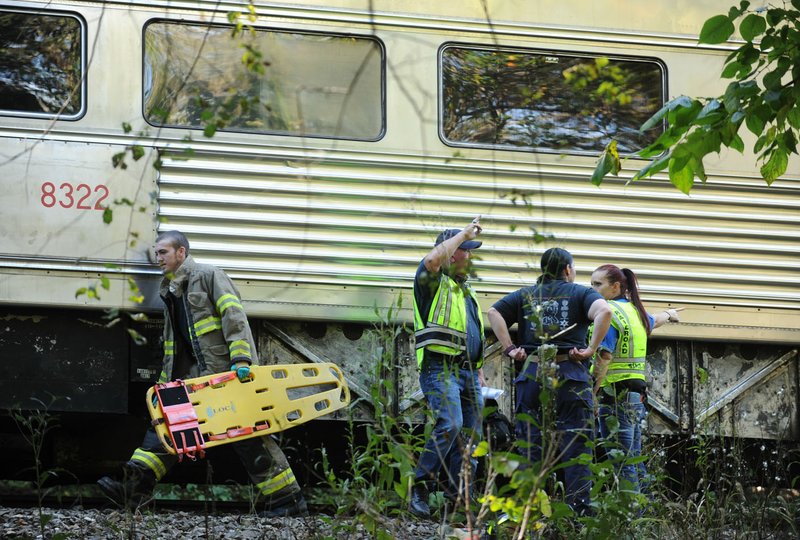The same slick rails that stalled a sightseeing train prevented an assist train that crashed into it from stopping, according to a National Transportation Safety Board report released Thursday on a 2014 accident.
A fall foliage sightseeing train of the Arkansas & Missouri Railroad Co. lost traction near Brentwood in Washington County on its way from Springdale to Van Buren on Oct. 16, 2014. A train sent to assist hit the tourist train head-on about 10:25 a.m. that morning.
Safety Board
The National Transportation Safety Board is the federal agency responsible for investigating accidents in involving air travel and transportation, highways, shipping and boats, pipelines and railroads, and any accident involving transportation of hazardous materials. It traces its origins to 1926, when Congress set up an agency to investigate the causes of aircraft accidents. The boar was taken out of the federal Department of Transportation in 1974 to ensure its independence.
All 39 passengers and four members of the crew from the two trains were taken to area hospitals and medical centers for injuries, though none were life-threatening. Estimated damage was $178,500, the report states.
"Event recorder data show that just before the collision the independent air brakes of the work train locomotive were fully applied when the locomotive was about 230 feet from the excursion train," the report said. "However, the work train could not stop in 230 feet, and it struck the excursion train." The assisting train was supposed to be going no faster than 20 mph under these conditions, the report says, but hit the stalled train at 24 mph despite constant braking for more than 75 yards.
According to the engineer of the sightseeing train, who wasn't named in the report: "The sight-seeing train stalled on track that was black and covered with crushed leafy organic material. This condition, known as black rail, reduces adhesion."
Other factors contributing to the wreck included patchy communications, violation of safety regulations and a partially bypassed system for spreading sand on the rails automatically in low-traction situations on the assisting train, the report said.
"The report says what it says, and they are very good at what they do," Ron Sparks, spokesman for Arkansas & Missouri Railroad, said Thursday of the safety board. The railroad company implemented most of the recommendations in the report long ago, he said, and is installing an improved radio system to eliminate dead spots that previously had to be filled with cellphone use, he said.
The railroad company has added a second locomotive to all sightseeing trains to increase power, revised its qualifications for working on and operating locomotives, put in new record keeping to track crew hours, rewritten rules for dispatchers, and tightened procedures for assisting stalled trains long before the transportation board report was issued, according to both Sparks and the report.
"The collision caused the lead trucks of both locomotives to derail and all four cars of the excursion train to separate from the locomotive," the report said. "The passenger cars rolled about 67 feet north." The travel of the cars was stopped by automatic brakes triggered by their separation from the locomotive. The only injury serious enough to be described in the report was of a railroad employee. The assisting train's conductor jumped from the locomotive's cab before impact and suffered back and ankle injuries requiring admittance to a hospital, the report says.
"One of the damaged passenger cars released about 40 gallons of diesel fuel from a generator fuel tank, but the fuel did not catch fire," the report says. The full text of the report is available at the transportation board's website at https://tinyurl.com/y9hvwtre.
Metro on 06/03/2017

